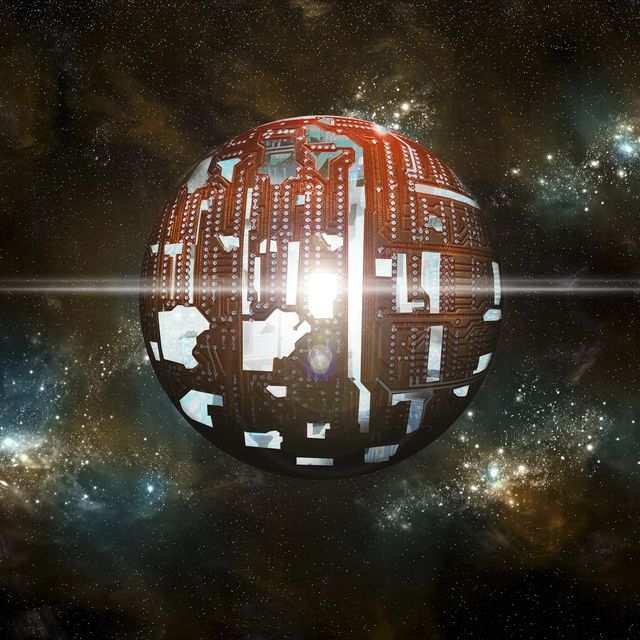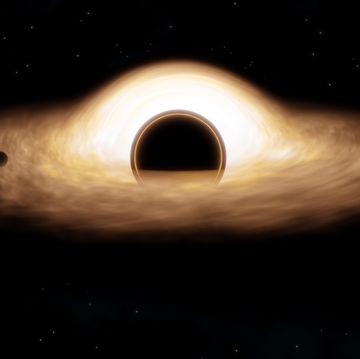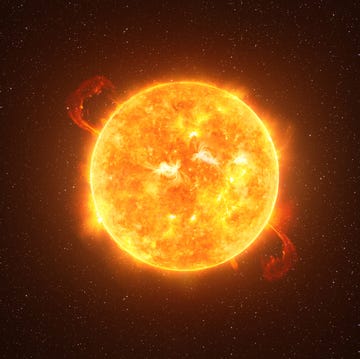Humankind is energy hungry. As our civilization industrialized over the last couple centuries, global energy consumption has spiked more than twentyfold, with no end in sight. When demand outstrips what we can reap from Earth and its vicinity, what will our power-craving descendants do?
A bold solution: the Dyson Sphere. This megastructure—usually conceived of as a gigantic shell enclosing the sun, lined with mirrors or solar panels—is designed to collect every iota of a star’s energetic output. In the case of our sun, that colossal figure is 384.6 septillion watts per second, or 3.846×1026 watts, which is on the order of a trillion times our current worldwide energy usage. What’s more, the interior of the Dyson Sphere could, in theory, provide far more habitable real estate than a measly planet.
Name: Dyson Sphere or Dyson Swarm
Named for: The late physicist Freeman Dyson (1923-2020), who proposed the megastructure concept in a 1960 Science paper, “Search for Artificial Stellar Sources of Infrared Radiation”
Selected Science Fiction Portrayals: Across a Billion Years, a 1969 novel by Robert Silverberg; the Star Trek: The Next Generation episode “Relics,” which first aired in 1992; and the 1995 novel The Time Ships by Stephen Baxter.
Physicist Freeman Dyson speculated that a technologically advanced race, reaching the limit of its civilization’s expansion because of dwindling matter and energy supplies, would seek to exploit their sun for all it is worth.
“One should expect that, within a few thousand years of its entering the stage of industrial development, any intelligent species should be found occupying an artificial biosphere which completely surrounds its parent star,” Dyson wrote in the 1960 Science paper that led to his becoming the namesake of this megastructure.
A Dubious Sphere
From an engineering perspective, a Dyson Sphere sounds pretty wild. And it is: As an immense, hollow ball, the structure is impossible. “An actual sphere around the sun is completely impractical,” Stuart Armstrong, a research fellow at Oxford University’s Future of Humanity Institute who has studied megastructure concepts, tells Popular Mechanics.
Armstrong says the tensile strength needed to prevent the Sphere from tearing itself apart vastly exceeds that of any known material. Another problem: The Sphere would not gravitationally bind to its star in a stable fashion. This is perhaps counterintuitive; you might think that a perfect sphere around a star would be stable. But if any part of the sphere were nudged closer to the star—say, by a meteor strike—then that part would be pulled preferentially toward the star, creating instability.
That’s too bad. If it could be stabilized, a Dyson Sphere built at 93 million miles from the sun, the same distance as Earth, would contain about 600 million times the surface area of our planet in its interior. However, comparatively little of the surface would be habitable on account of a lack of gravity. By spinning the whole sphere, you create gravity in the form of centrifugal force along an equatorial band. But this rotation would wrack the megastructure with yet more destructive stress.
If the Dyson Sphere were possible, its residents would be treated to an awesome vista. The “sides” of the inner Sphere would seem to contain the observer within a bowl-like tunnel, with the sun, constantly overhead, appearing as a light at the tunnel’s “end.” Astonishingly, along those sides, an object the size of the Earth would look miniscule. According to a Dyson Sphere FAQ posted by Armstrong’s Oxford colleague, Anders Sandberg, Earth would be about the size of a pea glimpsed at a distance of 100 meters (or, to Americanize the reference, from one football end zone to the other.)
If oceans, continents, and clouds were to be individually visible along the habitable band stretching upward from either horizon, they’d have to be monstrous.
Flocking Mirrors
Okay, so the fanciful Dyson Sphere appears to defy the laws of physics. A related concept—the Dyson Swarm—is more promising. “The Swarm is the more realistic model,” Armstrong says.
A Dyson Swarm consists of thousands of relatively small mirrors or solar panels in an array of orbits around the sun. Like a dense cloud of bees buzzing around a hive, a Dyson Swarm largely shrouds the sun from external view, capturing most of the available solar energy.
Armstrong says that a robot-driven manufacturing process could build up a Dyson Swarm in as little as several decades. His plan relies on exponential returns from a virtuous cycle, beginning with robots mining material from Mercury. The material is rocketed into orbit (not too tough, given Mercury’s weak gravity), then fabricated into an energy-collecting Dyson Swarm unit.
The first unit would take a decade to make, be less than a half-square-mile in area, and have “the thickness of tin foil,” Armstrong said. This unit would then power an uptick in mining and collector building, and so on. Three more similar cycles would commence, each grander in scale than the last. “It all depends on exponential feedback,” Armstrong says.
Transmogrified Planets
About half of Mercury’s mass—2 sextillion pounds or so—would be usable in the form of the elements oxygen and iron, Armstrong reckons. These elements could be combined to form an iron oxide called hematite, which we humans have used to make mirrors since antiquity. The mirrors could reflect sunlight to power a generator akin to a solar thermal energy plant but adapted for operation in space.
After 40 years of getting worked over, Mercury would be transmogrified, or almost magically altered, and totally kaput. The small planet would have been converted into a horde of mining and manufacturing robots, powered by fleets of Dyson Swarm solar collectors. Making a full Dyson Swarm that would catch nearly all of the sun’s rays, though, would require dismantling perhaps the entire inner solar system—Mercury, Venus, Earth, and Mars. But once engineers have reached this advanced stage, Armstrong says, this prospect wouldn’t seem so daunting. Strip-mining Venus would take merely a year given all the available energy and robotics following Mercury’s demise.
In devising this Dyson Swarm game plan, Armstrong assumed—conservatively, he thinks—only a one-tenth efficiency for rocketing material off Mercury. The other 90 percent of available energy would go toward mining and processing ore. He assumed further that the mirror and associated generator would reap just a third of the available solar energy, less than some of today’s solar concentrator efficiencies.
Living in the Dyson Swarm Era
If we’re going to destroy the Earth to build the swarm, then obviously we’ll need some habitat units amidst the Swarm. These could come in the form of large, rotating space colonies, like O’Neill Cylinders, placed at nice, temperate, average Earth–Sun distances, and in safe zones where Swarm solar collecting units would not swoop through. The habitats could be configured to receive energy via lasers from the vast Swarm network.
Then again, creating Earth-like oases amidst the Swarm as replacements for our departed planet might not be the true motivation of a Dyson Swarm society. A commonly suggested reason why humankind might one day desire all the Sun’s radiated energy is to power incredibly sophisticated computers. Maybe those computers would, in fact, be us—in the form of post-biological consciousness with no need for air, water, or food.
“When thinking of how future people may view [building a megastructure], we tend to get caught up with specific images of various habitats, with natural grass and other things,” Armstrong says. “But our values may have shifted . . . we might be living in machines ourselves.”
This story was published in 2014. It’s been updated twice after the 2020 passing of Freeman Dyson, the sphere’s theoretical creator.















